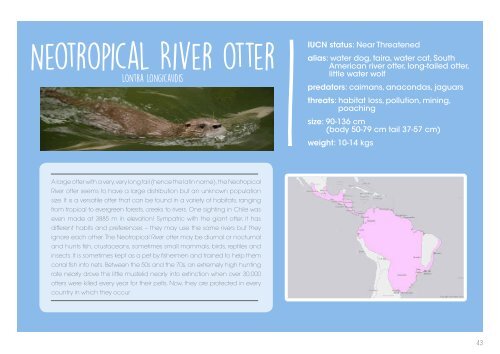OTTERS!
joopj4x
joopj4x
You also want an ePaper? Increase the reach of your titles
YUMPU automatically turns print PDFs into web optimized ePapers that Google loves.
Neotropical River otter<br />
Lontra longicaudis<br />
IUCN status: Near Threatened<br />
alias: water dog, taira, water cat, South<br />
American river otter, long-tailed otter,<br />
little water wolf<br />
predators: caimans, anacondas, jaguars<br />
threats: habitat loss, pollution, mining,<br />
poaching<br />
size: 90-136 cm<br />
(body 50-79 cm tail 37-57 cm)<br />
weight: 10-14 kgs<br />
A large otter with a very, very long tail (hence the latin name), the Neotropical<br />
River otter seems to have a large distribution but an unknown population<br />
size. It is a versatile otter that can be found in a variety of habitats, ranging<br />
from tropical to evergreen forests, creeks to rivers. One sighting in Chile was<br />
even made at 3885 m in elevation! Sympatric with the giant otter, it has<br />
different habits and preferences – they may use the same rivers but they<br />
ignore each other. The Neotropical River otter may be diurnal or nocturnal<br />
and hunts fish, crustaceans, sometimes small mammals, birds, reptiles and<br />
insects. It is sometimes kept as a pet by fishermen and trained to help them<br />
corral fish into nets. Between the 50s and the 70s, an extremely high hunting<br />
rate nearly drove this little mustelid nearly into extinction when over 30,000<br />
otters were killed every year for their pelts. Now, they are protected in every<br />
country in which they occur.<br />
43


